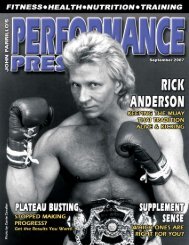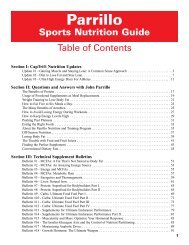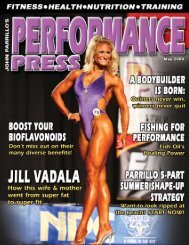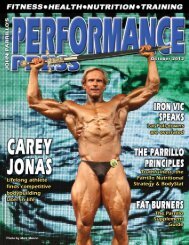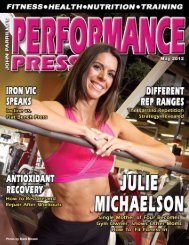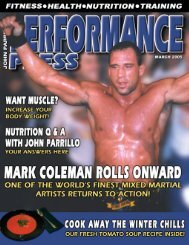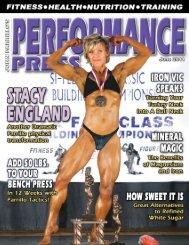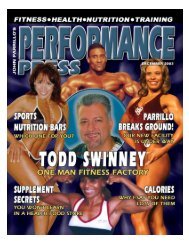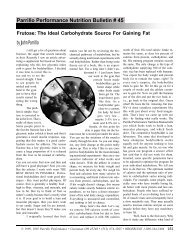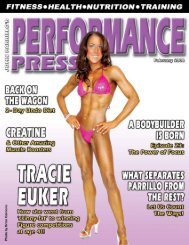A Monthly Magazine For All Bodybuilding, Fitness - Parrillo ...
A Monthly Magazine For All Bodybuilding, Fitness - Parrillo ...
A Monthly Magazine For All Bodybuilding, Fitness - Parrillo ...
Create successful ePaper yourself
Turn your PDF publications into a flip-book with our unique Google optimized e-Paper software.
Understanding Carbohydrates<br />
secretion signals your body to store fat.<br />
Most of the “fat-free goodies” that we<br />
find on the grocers shelves are loaded<br />
with sugar. Start reading the labels. You<br />
might be surprised at what you find!<br />
The fat-free title can sometimes be just<br />
a bit misleading especially if the product<br />
is loaded with fat producing sugar.<br />
Fructose is just a bit different from the<br />
simple carbs in that it doesn’t affect<br />
blood sugar and insulin. Fructose is<br />
actually converted into fat before it<br />
even hits your bloodstream. Fructose<br />
cannot be used to restore muscle glycogen<br />
levels and as a result is of no<br />
benefit at all to the athlete. Sugar-loaded<br />
sports drinks, even those containing<br />
fructose, aren’t going to do for you<br />
what they should and you would do<br />
well to avoid them. Again, read the labels.<br />
You might be surprised at what<br />
you find!<br />
Simple sugars no matter the form (or<br />
source) will never benefit you in your<br />
quest to build a lean, muscular body.<br />
Be a conscious label reader and start<br />
checking for fats and sugar as well.<br />
You’ll be surprised at how many products<br />
contain simple sugars. Starchy and<br />
fibrous carbs are both “complex” carbohydrates<br />
(polysaccharides) in that<br />
they digest slowly and allow for a sustained<br />
release of glucose into the bloodstream.<br />
This results in steady blood<br />
sugar level and prevents the spikes of<br />
insulin that encourage fat storage. <strong>All</strong><br />
carbohydrates in your meal plan should<br />
come from slow-release polysaccharides.<br />
Starchy carbs will be your bodies<br />
preferred fuel source. It would be<br />
my preference that your starchy carbs<br />
come from natural, unrefined sources.<br />
More nutrients are preserved and available<br />
to your body when you choose<br />
Sweet potatoes<br />
are a perfect<br />
source of slowrelease<br />
carbohydrates<br />
“Complex” carbohydrates<br />
(polysaccharides)<br />
digest<br />
slowly and allow<br />
for a sustained<br />
release of glucose<br />
into the<br />
bloodstream.<br />
Control insulin<br />
effectively by<br />
eating fibrous<br />
carbs with every<br />
meal.<br />
unrefined starchy carbs. Good choices<br />
for your starchy carbohydrates would<br />
include barley, brown rice, corn,<br />
chickpeas, garbanzo beans, lima beans,<br />
oatmeal, peas, pinto beans, kidney<br />
beans, potatoes, and sweet potatoes. I<br />
always recommend these foods be consumed<br />
either fresh or frozen. Canned<br />
vegetables are discouraged as they lack<br />
nutritional potency and are often<br />
loaded with salt and preservatives.<br />
Fibrous carbs, as the name implies,<br />
are higher in fiber than their starchy<br />
counterparts. Fibrous carbs, due to the<br />
higher fiber (cellulose) content, don’t<br />
offer quite the same energy yield as<br />
starchy carbs but fibrous carbs serve a<br />
dual benefit in your meal plan. Fiber<br />
carbs yield a vast array of vitamins, minerals<br />
and electrolytes and slow down<br />
the digestive process. A slower digestive<br />
rate yields a slower release of<br />
glucose into the bloodstream – which<br />
is a great thing for a bodybuilder. This<br />
allows us to avoid the peaks in blood<br />
sugar that create adipose tissue. We<br />
can control insulin effectively by eating<br />
fibrous carbs with every meal.<br />
Fiber is contained in your “salad”<br />
vegetables: broccoli, cauliflower, asparagus,<br />
green beans, spinach, kale,<br />
cabbage, celery, carrots, onions,<br />
squash and zucchini. Again, my preference<br />
is that your vegetables be<br />
fresh.<br />
I hope you have gotten a better understanding<br />
of carbohydrates as a result<br />
of our discussion. Now you have<br />
a good basic understanding as to<br />
what and how carbohydrates should<br />
be used for bodybuilding. I will relate<br />
how to construct your meal plan<br />
for maximal results in a future article.<br />
Next month, I’ll be straying from this<br />
series to do an athlete profile. I will<br />
show you firsthand how <strong>Parrillo</strong>-style<br />
nutrition led one hungry teenage<br />
bodybuilder to the NPC Jr. National<br />
Heavyweight championship title! We<br />
will give you a real world example of<br />
all the <strong>Parrillo</strong> Principles in action!<br />
Info-Line: 513•531•1311 John <strong>Parrillo</strong>’s Performance Press • August 1999 13



